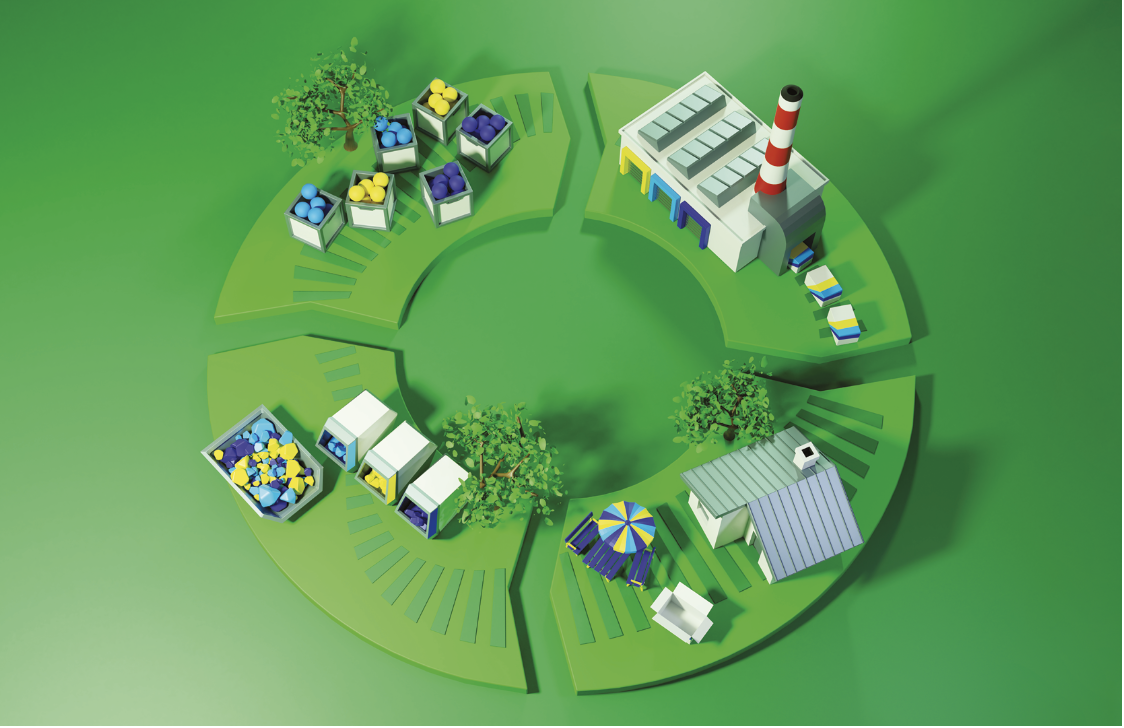Here’s why the circular economy means less carbon and more profit.
In 1980, as a child, I was walking on the beautiful island of Mauritius with my mother and grandfather when we stumbled upon a group of kids crafting cars out of discarded soft drinks cans. Little did I know that this chance encounter would shape my perspective on entrepreneurship for the rest of my life. Forty-four years on, I hold that memory very dearly as a symbol of evolution.
The ingenious act of turning waste into innovation epitomizes the essence of circularity. Where others saw mere trash, one individual envisioned possibility – the transformation of discarded resources into valuable products. This concept not only celebrates human creativity and optimism, but also holds profound implications for the economy. By repurposing materials, entrepreneurs can slash production costs, boost profit margins and contribute to resource efficiency, thereby mitigating the strain on our natural ecosystems.
A journey in circularity
In 2006, I started a venture with some friends, repurposing PVC billboards into accessories such as wallets, aprons and bags – following in the wake of the successful German start-up, Freitag. Our initiative demonstrated the viability of circular business models, leveraging waste materials to engage consumers and drive profitability – although operational challenges led to the venture’s closure in 2010. It was to serve as a catalyst, propelling me to establish Spin Ventures as a venture capital firm and venture accelerator with a singular focus on circularity. My journey reflects the evolution of the wider discussion on circularity, within the entrepreneurial and business communities, and at a policy level.
Underpinning that evolution is a revolution in materials that is being driven by regenerative agriculture, biomaterials and recycled resources. These are creating incredible opportunities, although discerning truly sustainable solutions requires rigorous evaluation. Superficial claims of environmental friendliness may mask hidden environmental costs, necessitating a holistic approach to life cycle assessment.
Yet the benefits can be real, and substantial. Consider the shift from traditional manufacturing to distributed production facilitated by technology. Now imagine a plastic toy. Most plastic companies today manufacture toys in regions with lower resources, labor and logistics costs, leading to a strong marketing and promotional push to drive profitability. However, today’s technology enables a different approach. Imagine your children engaging with an interactive story on your iPad, then sending an order to purchase one of the characters. With advancements in technology, you can pick a plastic bottle, recycle it, shred it in your own building, and access a 3D printing hub – whether your own or a shared one on a distributed manufacturing platform.
This process results in minimal emissions, delivering a more engaging product at the same or lower price, and with higher profitability. This exemplifies the most important message for leaders: circularity equals less carbon and more profit.
While challenges abound in transitioning to circular supply chains, technological innovation and data accessibility offer promising solutions. Investment in training and innovation is crucial to navigating this transformative journey toward a sustainable future aligned with economic growth.
Embracing circularity is not merely an environmental imperative, but a strategic opportunity for businesses to thrive in a rapidly evolving landscape. Leaders who embrace this evolutionary challenge stand to unlock new avenues of growth, profitability and sustainability.
Leading the pack
Real-world examples abound of companies that are embracing sustainable practices and reaping the rewards. One is Refresh Global, a team of world-class designers, scientists and business innovators tackling one of the biggest environmental challenges of our time: textile waste. The firm turns it into new, planet-friendly raw materials.
In the realm of consumer electronics, consider the plastic toy industry. While traditional manufacturing methods contribute to environmental degradation, startups like Supernovas, a circular design company, offer sustainable alternatives. By prioritizing recycled materials and innovative production processes, Supernovas reduces carbon emissions while maintaining profitability.
Similarly, Sparxell leads the charge in sustainable pigments for coloring products. Their biodegradable color platform utilizes the physical structures found in nature, eliminating the need for toxic chemicals. With Sparxell’s innovative approach, companies can achieve vibrant colors without harming the environment.
In parallel with corporate initiatives, government regulations play a crucial role in incentivizing and enforcing sustainable practices. In the European Union, mandates such as the Corporate Sustainability Reporting Directive
and Corporate Sustainability Due Diligence Directive (widely known as CSRD and CS3D) compel organizations to prioritize environmental and social responsibility. Data infrastructure, powered by generative AI, facilitates transparency and traceability throughout supply chains, empowering consumers to make informed choices based on environmental impact.
In addition, the EU’s Circular Economy Action Plan sets out ambitious targets for waste reduction, recycling, and resource efficiency, signaling a paradigm shift towards circularity at the policy level. And global initiatives such as the Sustainable Development Goals provide an overarching framework for businesses to align their strategies with broader societal and environmental objectives.
The convergence of technological innovation, regulatory pressure, and consumer demand is certain to accelerate the adoption of circular business models. Companies that embrace this shift proactively will not only future-proof their operations but also position themselves as leaders in sustainability and innovation.
A defining opportunity
The nexus of circularity, profitability and environmental stewardship represents a defining opportunity for businesses in the 21st century. By reimagining supply chains, harnessing technology and prioritizing environmental responsibility, companies can chart a course toward a more resilient, equitable, and prosperous future for
all stakeholders.
As leaders, we are tasked with navigating the complexities of the modern economy. As we do, let us seize this moment to forge a path towards a truly circular and sustainable world.
Nic Gorini is general partner at Spin Ventures.

